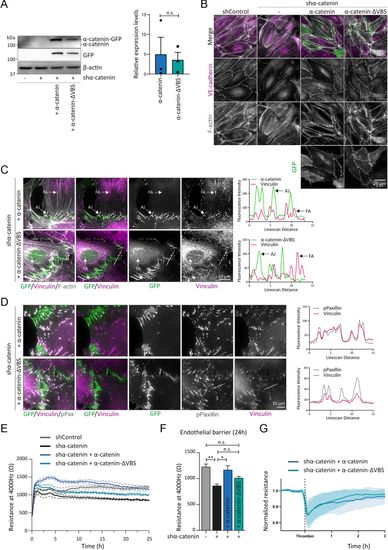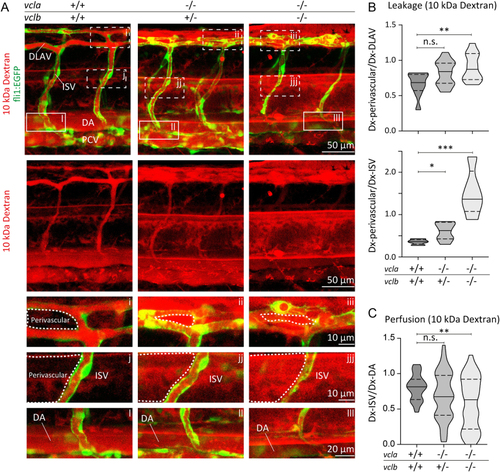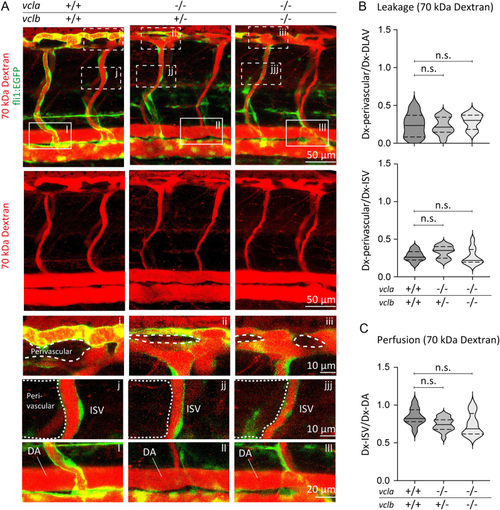- Title
-
Vinculin strengthens the endothelial barrier during vascular development
- Authors
- van der Stoel, M.M., Kotini, M.P., Schoon, R.M., Affolter, M., Belting, H.G., Huveneers, S.
- Source
- Full text @ Vasc Biol
|
Junctional vinculin strengthens the endothelial barrier in vitro. (A) Representative Western blot analysis of shControl and shα-catenin transduced HUVECs rescued with lentiviral expression of α-catenin–GFP or α-catenin–∆VBS–GFP. Blotted for α-catenin, GFP or β-actin. Bar graphs indicate the average ± s.e. expression levels of α-catenin–GFP and α-catenin–ΔVBS–GFP in shα-catenin-transduced HUVECs relative to endogenous α-catenin levels in shControl HUVECs. n.s., non-significant (non-parametric Wilcoxon matched-pairs signed-rank test). Data are from three independent experiments. (B) Representative immunofluorescent images of shControl and shα-catenin-transduced HUVECs rescued with lentiviral expression of α-catenin–GFP or α-catenin–∆VBS–GFP. Stained for F-actin (grey) and VE-cadherin (magenta). (C) Representative IF images of shα-catenin HUVECs rescued with α-catenin–GFP or α-catenin–∆VBS–GFP (green) that were stained for vinculin (magenta) and F-actin (grey). Colocalisation of vinculin with α-catenin–GFP or α-catenin–ΔVBS–GFP was analysed by line scans displaying signal intensity (arbitrary units) across the AJs and FAs as indicated. Scale bar, 10 µm. (D) Representative IF images of shα-catenin HUVECs rescued with α-catenin–GFP or α-catenin–∆VBS–GFP (green) that were stained for vinculin (magenta) and phosphor-Paxillin Tyr118 (grey). Colocalisation of vinculin with pPaxillin was analysed by line scans displaying signal intensity (arbitrary units) across FAs as indicated. Scale bar, 10 µm. (E) Line graph showing the average resistance ± s.e. measured with ECIS at 4000 Hz of indicated endothelial monolayers over time. Data are from three independent experiments. (F) Bar graphs representing the average resistance ± s.e. measured with ECIS at 4000 Hz of indicated endothelial monolayers after 24 h. Data are from three independent experiments. n.s., non-significant, *P < 0.05, **P < 0.01, ***P < 0.001 (one-Way ANOVA with Tukey’s post hoc test for multiple comparisons). (G) Line graph showing the average resistance ± s.d. measured with ECIS at 4000 Hz of indicated endothelial monolayers over time following treatment with the permeability factor thrombin. Data are normalised to the baseline values prior to thrombin treatment and are derived from two independent experiments. |
|
Vinculin ensures vascular barrier function for 10 kDa dextran. (A) Images of ISVs from 48 hpf Tg(fli1:EGFP) vcla+/+;vclb+/+, vcla−/−;vclb+/− or vcla−/−;vclb−/− embryos injected with 10 kDa rhodamine-dextran (red). Lower panels are single-channel images of the rhodamine signal. Scale bars, 50 µm. (A, i-iii) Corresponding close-up images showing the dextran leakage in the perivascular area around the dorsal longitudinal anastomotic vessel (DLAV). (A, j-jjj) Corresponding close-up images showing the dextran leakage in the perivascular area around an intersegmental vessel (ISV). Scale bars, 10 µm. (A, l-lll) Close-up images of an ISV and the dorsal aorta (DA) showing the rhodamine signal within these vessels. Scale bar, 20 µm. (B) Violin plots showing the average leakage ± s.e. of 10 kDa dextran into the perivascular area of the DLAV or ISVs normalised to the dextran inside the DLAV or ISVs from 48 hpf embryos. The dotted lines represent the quartiles and the straight lines represent the median, n = 10 vcla+/+;vclb+/+, n = 25 vcla−/−;vclb+/− and n = 13 vcla−/−;vclb−/− embryos, n.s., non-significant, *P < 0.05, **P < 0.01, ***P < 0.001 (one-way ANOVA and Dunnett’s post-test). PCV, posterior cardinal vein. (C) Violin plot showing the ISV perfusion determined as the ratio between fluorescent dextran levels inside the ISV ± s.e. and dextran inside the dorsal aorta (DA) from 48 hpf embryos. The dotted lines represent the quartiles, the straight lines represent the median. n = 10 vcla+/+;vclb+/+, n = 25 vcla−/−;vclb+/− and n = 13 vcla−/−;vclb−/− embryos. |
|
Loss of vinculin does not impair vascular barrier function for 70 kDa dextran. (A) Images of ISVs from 48 hpf Tg(fli1:EGFP) vcla+/+;vclb+/+, vcla−/−;vclb+/− or vcla−/−;vclb−/− embryos injected with 70 kDa rhodamine-dextran (red). Lower panels are single channel images of the rhodamine signal. Scale bars, 50 µm. (A, i-iii) Corresponding close-up images showing the dextran levels in the perivascular area around the dorsal longitudinal anastomotic vessel (DLAV). (A, j-jjj) Corresponding close-up images showing the dextran levels in the perivascular area around an intersegmental vessel (ISV). Scale bars, 10 µm. (A, l-lll) Close-up images of an ISV and the dorsal aorta (DA) showing the rhodamine signal within these vessels. Scale bar, 20 μm. (B) Violin plot showing the average leakage ± s.e. of 70 kDa dextran into the perivascular area of the DLAV or ISVs normalised to the dextran inside the DLAV or ISVs from 48 hpf embryos. The dotted lines represent the quartiles, the straight lines represent the median, n = 7 vcla+/+;vclb+/+, n = 16 vcla−/−;vclb+/− and n = 7 vcla−/−;vclb−/− embryos, n.s. non-significant, one-way ANOVA and Dunnett’s post-test. (C) Violin plot showing the ISV perfusion determined as the ratio between fluorescent dextran levels inside the ISV ± s.e. and dextran inside the dorsal aorta (DA) from 48 hpf embryos. The dotted lines represent the quartiles, the straight lines represent the median, n = 10 vcla+/+;vclb+/+, n = 16 vcla−/−;vclb+/− and n = 8 vcla−/−;vclb−/− embryos. |



